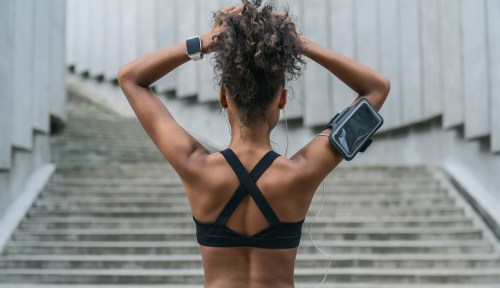Our editors independently select these products. Making a purchase through our links may earn Well+Good a commission
As essential as working out is for our physical and mental health, it’s always not doing our scalp (and by extension, our hair) any favors. According to physician Mary Wendel, MD, if you’re not washing your hair after you work up a sweat, a buildup of debris and oil starts to settle in.
“There’s this new philosophy out there that shampooing less is better, and there’s not much truth to that,” says Dr. Wendel, a Massachusetts-based internist who founded a medical practice dedicated to treating female hair loss, Medi Tresse. “The buildup of oil, dirt, and sweat over several days clogs up the pores and can be very pro-inflammatory to the scalp,” she explains, noting that you may even start to experience dry, flaky skin, and itching or irritation.
Exactly how often you need to wash your hair will vary depending on how much you sweat (think restorative yoga vs. HIIT class) and your natural hair texture (fellow fine-haired friends, you probably already know you gotta shampoo more). “Not everybody needs to shampoo every day, but waiting two weeks to shampoo, for most people, is not healthy for the scalp,” she says, adding, “If your scalp isn’t healthy, you’re not going to grow your hair as well.” Ahead, Dr. Wendel breaks down the basics on a few more myths that might just make you feel better about your workout hair-care routine.
Myth #1: Washing your hair post-workout is all you need to get your scalp back on track
Yes, washing your hair often is non-negotiable, but Dr. Wendel shares that your scalp is also probably in need of a more intense cleanse. “It doesn’t have to be after every workout or anything, but I recommend a scalp scrub or scalp cleanse even just once a week or every two weeks,” shel says. At her office, she uses the Medi Tresse Root Cleanse Shampoo ($40) along with a silicone scalp massage brush to gently remove any debris. “The scalp can get irritated just from the natural elements of the skin and oil, so cleaning that area off with a scalp root cleanse and a good moisturizing conditioner afterward is a good idea.”
Myth #2: Dry shampoo will clean your hair
Despite its name, dry shampoo isn’t doing anything to remove scalp buildup—in fact, it’s really only adding to it. “What it does is it hides the oils so that the hair doesn’t look dirty or greasy, but it truly doesn’t do anything to clean either the hair shaft or the scalp,” Dr. Wendel explains.
Even so, she assures that it’s safe to use dry shampoo in moderation. “If you want to spray on some dry shampoo, style your hair, and go, that’s fine. But I would recommend you wash it out later that day or the next day because it’s just going to build up on the scalp and on the hair, and over time, it’s not healthy to do that,” Dr. Wendel says. You’ll also want to follow up with a moisturizing conditioner since dry shampoo can be, well, drying on the hair.
If your hair still feels dry after shampooing and conditioning, Dr. Wendel recommends applying an argan oil like the Pattern Argan Hair & Scalp Oil Blend ($25) to help restore moisture. “As the hair grows, as it leaves the hair follicle, there’s no blood supply in it anymore, so whatever moisture you want to put on your hair has to come externally,” she says.
Myth #3: Pulling your hair back during workouts can cause hair loss
Brushing your hair back into the sleekest ponytail possible is sometimes necessary in order to keep strands out of your face during a high intensity workout. But can it really lead to hair loss? It certainly can, but Dr. Wendel shares that it only becomes a problem for people who wear their hair slicked back for several hours every single day. “There’s something called traction alopecia, which is actually hair loss due to really tight hair pulling,” she explains, noting that it typically occurs in athletes like dancers and gymnasts. “If you do it day after day, it does put a strain on the hair follicle and it can cause hair loss and we see the hair lines moving back. But if you’re just doing it for an hour—even if it’s every day—and then you’re letting your hair go, it’s not going to have that same kind of effect.”
If you’re still concerned, Dr. Wendel suggests styling your hair more loosely with a softer tie like Slip’s Silk Scrunchies ($39 for a pack of 6), and taking your hair down immediately after working out.
Myth #4: You should never wear a hat while you work out
If a baseball cap (or a beanie in the winter months) is part of your running uniform, Dr. Wendel says that there’s no need to worry about this leading to hair loss or thinning. “Wearing a cap while you’re working out or running is absolutely fine as long as you’re not wearing it all day, every day,” she shares. It only becomes a problem when you wear a hat for especially long durations and don’t allow the scalp to air out. If you wear your hat several times each week, try to opt for something that’s washable so you’re able to clean out the oil and sweat regularly.
Sign Up for Our Daily Newsletter
Get all the latest in wellness, trends, food, fitness, beauty, and more delivered right to your inbox.
Got it, you've been added to our email list.











